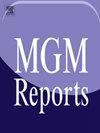Outcome of creatine supplementation therapy in phosphoglucomutase-1 deficiency associated congenital disorders of glycosylation: Novel insights
IF 1.9
4区 医学
Q3 GENETICS & HEREDITY
引用次数: 0
Abstract
Background
Biallelic pathogenic variants in PGM1 result in phosphoglucomutase 1 (PGM1) deficiency that is one of the congenital disorders of glycosylation (CDG) (PGM1-CDG). Phenotypic spectrum includes congenital malformations, and muscular, cardiac, hepatic, endocrine and hematologic phenotypes. Current treatment consists of D-galactose therapy that results in clinical and biochemical improvements. To improve fatigue, and exercise intolerance, we started creatine supplementation therapy.
Material and methods
We reviewed electronic patient chart. We applied Nijmegen Pediatric CDG Rating Scale (NPCRS) and The Functional Assessment of Chronic Illness Therapy Fatigue scale (FACIT-F). We measured creatine metabolism biomarkers.
Results
This is a 29-year-old female with PGM1-CDG, confirmed diagnosis by clinical exome sequencing. She has been treated with D-galactose therapy which did not improve her fatigue and exercise intolerance. She was started on creatine supplementation therapy at the age of 27 years which led to decreased daytime sleeping, increased exercise capacity and improvements in her NPCRS, and FACIT-F. Her plasma guanidinoacetate was low. She had elevated urine galactitol on D-galactose therapy.
Discussion
PGM1-CDG associated myopathy is likely due to combination of several factors including abnormal muscle carbohydrate metabolism, abnormal N-glycosylation of proteins involved in the muscle functions and creatine transport and altered muscle energy homeostasis. It was previously shown that creatine supplementation therapy improves myopathy in patients with mitochondrial cytopathies. We think that the use of creatine supplementation therapy coincided with improvements in fatigue and exercise intolerance subjectively and objectively in our patient.
肌酸补充治疗与磷酸葡萄糖糖化酶-1缺乏相关的先天性糖基化疾病的结果:新的见解
PGM1的双等位致病变异可导致磷酸葡萄糖糖化酶1 (PGM1)缺乏,这是先天性糖基化(PGM1-CDG)疾病之一。表型谱包括先天性畸形、肌肉、心脏、肝脏、内分泌和血液学表型。目前的治疗包括d -半乳糖治疗,结果临床和生化改善。为了改善疲劳和运动不耐受,我们开始了肌酸补充疗法。材料与方法回顾电子病历。我们采用奈梅亨儿童CDG评定量表(NPCRS)和慢性疾病治疗疲劳功能评定量表(FACIT-F)。我们测量了肌酸代谢生物标志物。结果29岁女性,PGM1-CDG,经临床外显子组测序确诊。她接受了d -半乳糖治疗,但并没有改善她的疲劳和运动不耐受。她在27岁时开始接受肌酸补充治疗,导致白天睡眠减少,运动能力增加,NPCRS和FACIT-F改善。血浆中胍丁酯含量低。她接受d -半乳糖治疗后尿中半乳糖醇升高。pgm1 - cdg相关肌病可能是由多种因素共同作用的结果,包括肌肉碳水化合物代谢异常、参与肌肉功能和肌酸运输的蛋白质n -糖基化异常以及肌肉能量稳态改变。先前的研究表明,肌酸补充疗法可改善线粒体细胞病变患者的肌病。我们认为肌酸补充疗法的使用与我们患者主观上和客观上的疲劳和运动不耐受的改善相一致。
本文章由计算机程序翻译,如有差异,请以英文原文为准。
求助全文
约1分钟内获得全文
求助全文
来源期刊

Molecular Genetics and Metabolism Reports
Biochemistry, Genetics and Molecular Biology-Endocrinology
CiteScore
4.00
自引率
5.30%
发文量
105
审稿时长
33 days
期刊介绍:
Molecular Genetics and Metabolism Reports is an open access journal that publishes molecular and metabolic reports describing investigations that use the tools of biochemistry and molecular biology for studies of normal and diseased states. In addition to original research articles, sequence reports, brief communication reports and letters to the editor are considered.
 求助内容:
求助内容: 应助结果提醒方式:
应助结果提醒方式:


